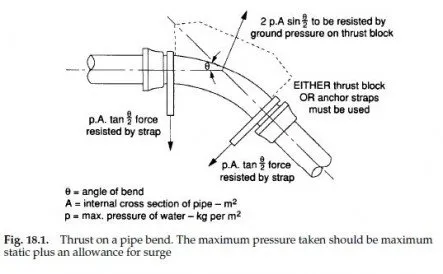The resident engineer may have to ensure that thrust blocks to pipes are adequate. A block acts primarily to transfer pipe thrust to the natural ground against which the block abuts. Hence, the nature of the ground is important. The force to be resisted on a bend with push in joints is shown in Fig. 18.1.

The internal water pressure taken should be the maximum static pressure occurring, plus an allowance for surge pressure. The block bearing area against the natural ground has to be sufficient to mobilize adequate resistance from the soil against pipe thrust. Where a bend points down, a weight block below the upper joint is usually necessary, the joint being strapped down to it. Particular care has to be taken when a bend down is required at the bank of a river or stream.
There may then be very little ground resistance to prevent the bend blowing off if the joint is the usual push-in type, hence the upper joint of the bend may require tying back to a suitable thrust block to resist the hydraulic force tending to push the bend off.
The watertightness test for a pipeline should be prescribed in the specification.
Care must be taken to fill the pipeline slowly to ensure release of all air. The usual practice is to fill from one end, having all washouts and hydrants open.
The latter are progressively closed along the line when they cease to emit air or mixed air and water. This may take a considerable time, as air pockets may get trapped and only slowly disperse. A satisfactory test cannot be achieved if an air pocket is left in the pipeline. After filling, the pipe should stand under pressure for 24 h before testing. This permits pipe expansion and absorption of water by asbestos cement or concrete pipes or by any mortar lining of steel or iron pipes. Normally pipelines are tested between valves, but on a trunk main these may be so far apart that temporary stop ends may be needed to test the pipeline in reasonable lengths. Especial care is needed in testing partly completed pipelines to ensure they are properly restrained against the high test pressures.
An experienced pipelaying contractor will know that care in making joints on a pipeline is rewarded many times over when the pipeline test shows the line is satisfactory. It is rarely possible to leave joints exposed before testing, so if a test fails it may take much time and trouble to find the leak causing it. When finally found it may be as simple as a twisted rubber ring in a push fit joint. It is not easy to make clean perfect joints in a muddy trench. The contractor can save himself money if he gives the jointer every facility to make a good joint easy access to see the underside of the pipe spigot, buckets of water and plentiful clean rags to ensure that joint faces and joint ring are scrupulously clean before the joint is assembled. No grease or jointing compounds should be permitted other than that which the pipe manufacturer recommends. Welders also need sufficient room and good lighting to make sure welds are adequate and should not be expected to weld up badly aligned pipes.